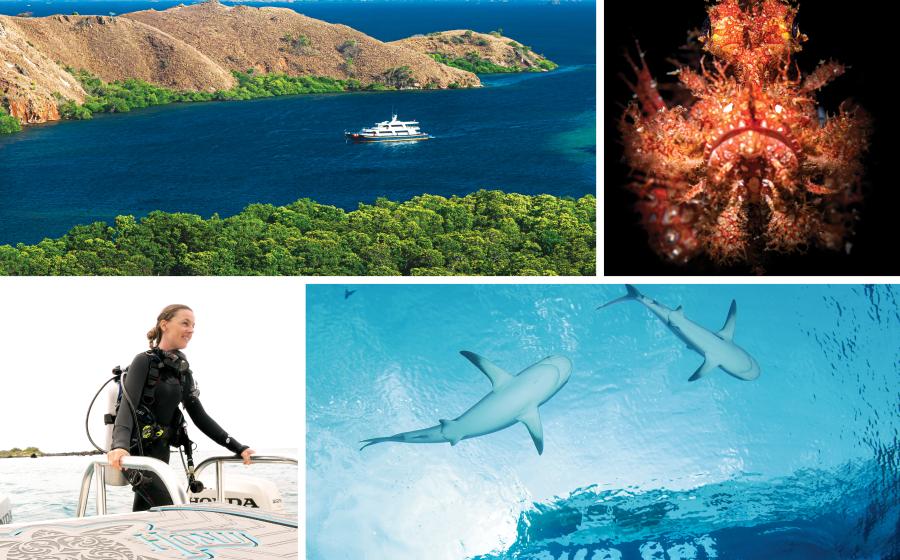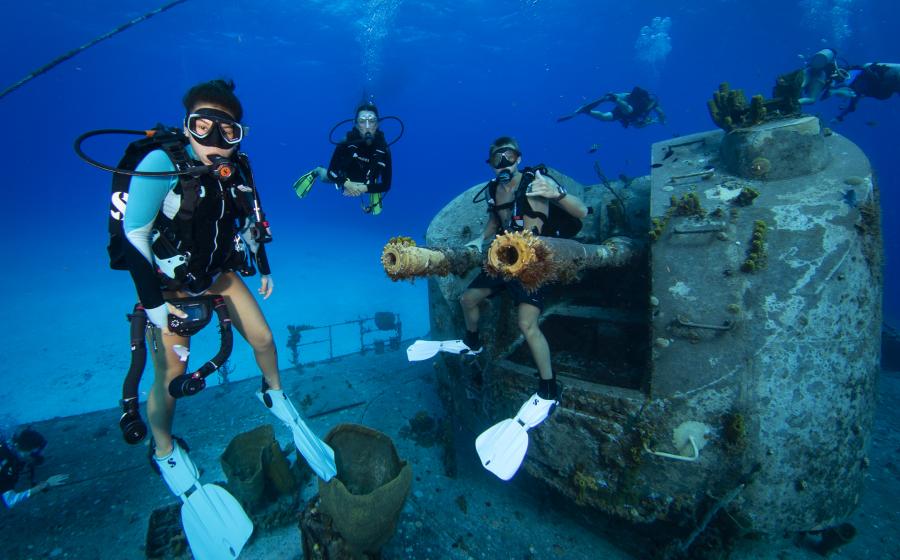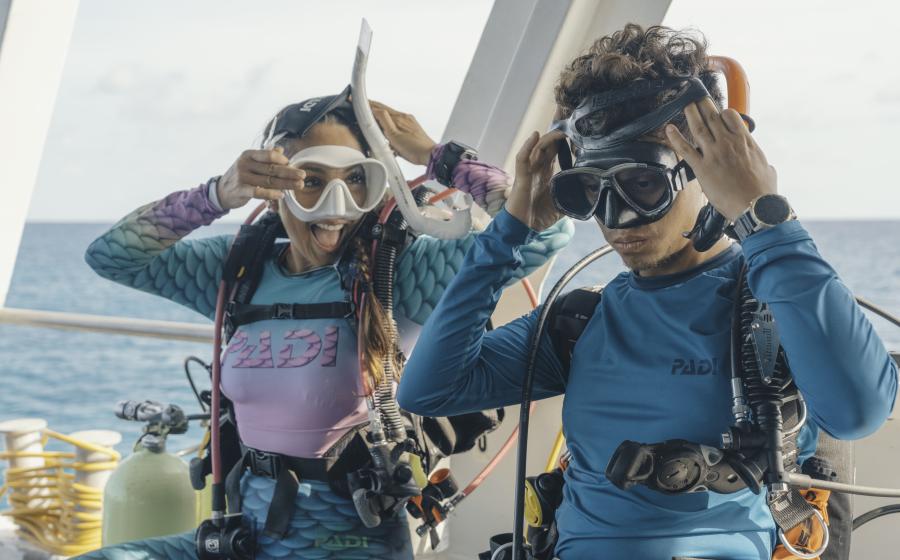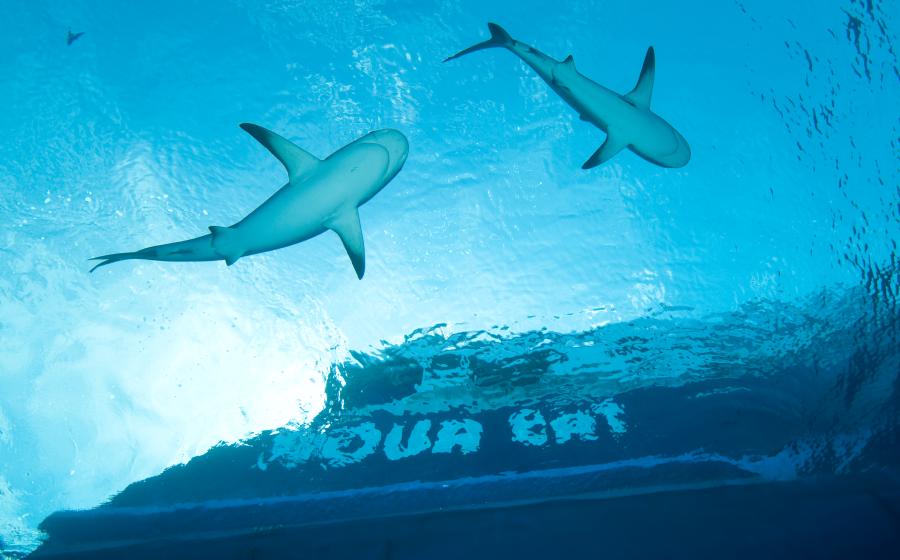Photo Diversity
 |
| Eagle ray by John Easley with Fuji S2 digital in Ikelite housing. |
 |
| Reef scenic by Art Schumer with Nikon D1X digital in Seacam housing. |
October 2003
By Stephen Frink
Photography is in the midst of a massive revolution, mostly as it relates to digital. Digital Photography Review recently posted statistics noting that worldwide digital camera sales were up 93 percent for the first half of 2003, while film cameras dropped 20 percent in the same time frame. Digital cameras shipped in Europe were up an astonishing 149 percent, while there was a corresponding 67 percent leap in North America.
How does that relate to underwater photography? For one thing, shooters are excited again. There are many innovative new digital products being introduced that make photography easier, and in some ways better than ever before. Of course, better equipment doesn't always mean better photos.
Having just taught my annual session of the Stephen Frink School of Underwater Photography, I was thinking back on how photo equipment has changed over the 20 years I've been teaching this course.
The Early Days
||
|---|
|  |
|
| Octopus by Doug Struchen with Nikonos V and close-up kit.|
In the first photo schools, most students had totally manual systems, like a Nikonos III and an Oceanic 2001 strobe. But by the mid-1980s the students were showing up with more sophisticated systems like Nikonos V cameras and through-the-lens (TTL) automatic strobes. Housed Nikon F series SLRs began to show up in students' hands about then as well.
In the mid-1990s, in what I call the "orange era," almost everyone was shooting Nikonos V cameras and SB105 strobes, motivated both by good marketing and what was truly a very clever product line. We'd see a few Sea & Sea Motor Marine cameras and Ikelite housings in the mix; but in the early '90s, Nikonos ruled consumer underwater photography.
 |
| Blue-striped grunt by Russ Nelson with Canon D60 digital in Sea & Sea housing, 100mm Canon macro lens. |
New Millennium, New Options
||
|---|
|  |
|
| Spiegel Grove by Mina Kuhn with Nikon N90s in Sea & Sea housing.|
Enter the new millennium, and shooters seemed to figure out that the Nikonos was great for wide angle, thanks to sharp water-contact 15mm and 20mm Nikkor lenses, but most small critters were scared off by the framers of the macro tubes and close-up kit. For skittish subjects like fish, the housed single-lens reflex camera was infinitely better. The market had matured, and those who took their photography seriously made the leap to housings.
For this year's class, the equipment mix was both eclectic and sophisticated. There were Nikonos shooters to be sure, but for the first time there were digital systems in various housings for the Nikon D1X and D100, Canon D60 and Fuji S2. There were housed film cameras, Nikon F5, F100s and N90s. And, as if in homage to that earlier era, there was even one photographer who was using an old Oceanic Hydro-35 housing for his Nikon F2, circa 1975, and turning in extraordinary images daily as well.
Does Equipment Make the Shooter?
||
|---|
|  |
|
| Juvenile queen angelfish by Jack Hardy with Nikon N90s in Aquatica housing.|
In underwater imaging, there is no question that certain tools are better-suited for certain tasks than other tools. Here are some observations made during the photo school:
> Those students trying to shoot yellowhead jawfish with their Nikonos extension tubes were doomed to frustration as there is no way that little fish is going to be stupid enough to willingly swim into the framer. For this type of photography, the advantage goes to those shooting housed 105mm macro lenses.
> On the other hand, those swimming against the current on the Spiegel Grove might have done well to trade their bulky housings and dome ports for the ergonomic ease and convenience of a Nikonos and 15mm lens.
> Digital offers the advantage of immediate review, but our digital shooters were sleep-deprived by the end of the week after staying up past their bedtime into the wee hours tweaking their digital files and downloading to CD for the daily critique.
> Film handles high-contrast situations, like the classic wide-angle "ball of sun," better than digital.
> Digital gives the photographer far more shots per dive.
> The Nikonos with close-up kit or extension tube is wonderful for the placid creatures on night dives and stationary reef dwellers.
> The housed SLRs are far better-suited to capturing skittish critters.
In the end, equipment is just one element of the total equation. Stellar photos come from the heart and the eye, not just the wallet. This year's class was verification of that, because extraordinary images came from each system, new and old, film and digital.
To read a more in-depth review of this year's class from the perspective of a student, please read John Easley's post at http://dive.scubadiving.com/members/tripreports.php?s=2121. For details of next year's class, visit www.waterhousetours.com.
|| |---|
| |
| Eagle ray by John Easley with Fuji S2 digital in Ikelite housing.|
|
| Eagle ray by John Easley with Fuji S2 digital in Ikelite housing.|
|| |---|
| |
| Reef scenic by Art Schumer with Nikon D1X digital in Seacam housing.|
|
| Reef scenic by Art Schumer with Nikon D1X digital in Seacam housing.|
October 2003
By Stephen Frink
Photography is in the midst of a massive revolution, mostly as it relates to digital. Digital Photography Review recently posted statistics noting that worldwide digital camera sales were up 93 percent for the first half of 2003, while film cameras dropped 20 percent in the same time frame. Digital cameras shipped in Europe were up an astonishing 149 percent, while there was a corresponding 67 percent leap in North America.
How does that relate to underwater photography? For one thing, shooters are excited again. There are many innovative new digital products being introduced that make photography easier, and in some ways better than ever before. Of course, better equipment doesn't always mean better photos.
Having just taught my annual session of the Stephen Frink School of Underwater Photography, I was thinking back on how photo equipment has changed over the 20 years I've been teaching this course.
The Early Days
|| |---|
| |
| Octopus by Doug Struchen with Nikonos V and close-up kit.|
In the first photo schools, most students had totally manual systems, like a Nikonos III and an Oceanic 2001 strobe. But by the mid-1980s the students were showing up with more sophisticated systems like Nikonos V cameras and through-the-lens (TTL) automatic strobes. Housed Nikon F series SLRs began to show up in students' hands about then as well.
|
| Octopus by Doug Struchen with Nikonos V and close-up kit.|
In the first photo schools, most students had totally manual systems, like a Nikonos III and an Oceanic 2001 strobe. But by the mid-1980s the students were showing up with more sophisticated systems like Nikonos V cameras and through-the-lens (TTL) automatic strobes. Housed Nikon F series SLRs began to show up in students' hands about then as well.
In the mid-1990s, in what I call the "orange era," almost everyone was shooting Nikonos V cameras and SB105 strobes, motivated both by good marketing and what was truly a very clever product line. We'd see a few Sea & Sea Motor Marine cameras and Ikelite housings in the mix; but in the early '90s, Nikonos ruled consumer underwater photography.
|| |---|
| |
| Blue-striped grunt by Russ Nelson with Canon D60 digital in Sea & Sea housing, 100mm Canon macro lens.|
|
| Blue-striped grunt by Russ Nelson with Canon D60 digital in Sea & Sea housing, 100mm Canon macro lens.|
New Millennium, New Options
|| |---|
| |
| Spiegel Grove by Mina Kuhn with Nikon N90s in Sea & Sea housing.|
Enter the new millennium, and shooters seemed to figure out that the Nikonos was great for wide angle, thanks to sharp water-contact 15mm and 20mm Nikkor lenses, but most small critters were scared off by the framers of the macro tubes and close-up kit. For skittish subjects like fish, the housed single-lens reflex camera was infinitely better. The market had matured, and those who took their photography seriously made the leap to housings.
|
| Spiegel Grove by Mina Kuhn with Nikon N90s in Sea & Sea housing.|
Enter the new millennium, and shooters seemed to figure out that the Nikonos was great for wide angle, thanks to sharp water-contact 15mm and 20mm Nikkor lenses, but most small critters were scared off by the framers of the macro tubes and close-up kit. For skittish subjects like fish, the housed single-lens reflex camera was infinitely better. The market had matured, and those who took their photography seriously made the leap to housings.
For this year's class, the equipment mix was both eclectic and sophisticated. There were Nikonos shooters to be sure, but for the first time there were digital systems in various housings for the Nikon D1X and D100, Canon D60 and Fuji S2. There were housed film cameras, Nikon F5, F100s and N90s. And, as if in homage to that earlier era, there was even one photographer who was using an old Oceanic Hydro-35 housing for his Nikon F2, circa 1975, and turning in extraordinary images daily as well.
Does Equipment Make the Shooter?
|| |---|
| |
| Juvenile queen angelfish by Jack Hardy with Nikon N90s in Aquatica housing.|
In underwater imaging, there is no question that certain tools are better-suited for certain tasks than other tools. Here are some observations made during the photo school:
|
| Juvenile queen angelfish by Jack Hardy with Nikon N90s in Aquatica housing.|
In underwater imaging, there is no question that certain tools are better-suited for certain tasks than other tools. Here are some observations made during the photo school:
> Those students trying to shoot yellowhead jawfish with their Nikonos extension tubes were doomed to frustration as there is no way that little fish is going to be stupid enough to willingly swim into the framer. For this type of photography, the advantage goes to those shooting housed 105mm macro lenses.
> On the other hand, those swimming against the current on the Spiegel Grove might have done well to trade their bulky housings and dome ports for the ergonomic ease and convenience of a Nikonos and 15mm lens.
> Digital offers the advantage of immediate review, but our digital shooters were sleep-deprived by the end of the week after staying up past their bedtime into the wee hours tweaking their digital files and downloading to CD for the daily critique.
> Film handles high-contrast situations, like the classic wide-angle "ball of sun," better than digital.
> Digital gives the photographer far more shots per dive.
> The Nikonos with close-up kit or extension tube is wonderful for the placid creatures on night dives and stationary reef dwellers.
> The housed SLRs are far better-suited to capturing skittish critters.
In the end, equipment is just one element of the total equation. Stellar photos come from the heart and the eye, not just the wallet. This year's class was verification of that, because extraordinary images came from each system, new and old, film and digital.
To read a more in-depth review of this year's class from the perspective of a student, please read John Easley's post at http://dive.scubadiving.com/members/tripreports.php?s=2121. For details of next year's class, visit www.waterhousetours.com.






